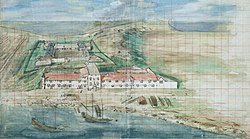Fort Zeelandia (Taiwan)
Fort Zeelandia ( Chinese 熱 蘭 遮 城 , Pinyin rèlánzhē chéng , W.-G. Re-lan che-ch'eng ) was a fortress owned by the Dutch East India Company (VOC) on the island of Formosa (Portuguese: Ilha Formosa, today Taiwan ) from 1624 to 1634. The place is in the catchment area of the later city of Anping, today a district in the city of Tainan .
history
In 1622 the Dutch tried to establish themselves on the nearby Pescadoren Islands ( Chinese 澎湖 群島 , Pinyin Pénghú Qúndǎo , W.-G. P'eng-hu Ch'ün-tao ), but in 1624 they had to give way to Chinese pressure. "Zeelandia" was the name of Martinus Sonck's ship, the last commandant on the Pescadors.
A headland on the Bay of “Taiwan” was chosen for the new base, from which access to the sea and thus to Batavia could be maintained in the event of a siege . However, you had to bring the fresh water from the land.
Most of the building materials used on the pescadors could be saved, but extensive deliveries of bricks from Batavia were necessary. A mixture of sand, mussels, glutinous rice and sugar was used as the mortar.
Fort Zeelandia served as the seat of the governor and the main administration. A settlement was built nearby. In addition, smaller bases were maintained in the region: Fort Provintia, Fort Utrecht and Fort Zeeburgh. Fort Noord-Holland, built on the northern tip of the island near “Keelung” ( Chinese 基隆 , Pinyin Jīlóng , W.-G. Ji-lung ) signaled the company's long-term expansion plans.
The fighting raging in the Chinese Empire between the Manchu troops advancing from the north and the forces of the Ming dynasty , which had been pushed to the south , did not remain without effects on Formosa. On April 30, 1661, the Chinese general Zheng Chenggong ( Koxinga ), a supporter of the Ming, began the siege of the fortress Zeelandia. In the following nine months around three quarters of the defenders died, relief from Batavia did not take place and finally the drinking water also ran out. On February 1, 1662, Governor Frederick Coyett signed a charter of surrender, surrendered the fortress with all goods on February 9, and in return received safe conduct for his soldiers and all civilians. Thus, after 38 years, the Dutch control of the southwestern Formosa ended. Koxinga founded the Ming supporting Kingdom of Tungning ( Chinese 東 寧王國 , Pinyin Dōngníng Wángguó , W.-G. Tungning Wangkuo ), which is also called the Kingdom of Yanping ( Chinese 延平 王國 ).
The facilities quickly fell into disrepair. The Chinese names changed repeatedly: Fort Orange (Oranje) ( Chinese 奧倫 治 城 ), Fort Taiwan ( Chinese 台灣 城 ) and finally Old Fort Anping ( Chinese 安平古堡 , Pinyin Ānpíng gǔbǎo ).
Fort Noord-Holland in the north was reoccupied by the Dutch in 1664. Although the 300-man crew succeeded two years later in repelling a Chinese attack of 6,000 men, it gradually became clear that trade on the previous scale was no longer possible. On October 18, 1668 it was therefore decided to leave Formosa for good.
VOC governors of Taiwan
| Martinus Sonck | 1624-1625 |
| Gerard F. de With | 1625-1627 |
| Pieter Nuyts | 1627-1629 |
| Hans Putmans | 1629-1636 |
| Johan Van Der Burg | 1636-1640 |
| Paulus Traudenius | 1640-1643 |
| Maximilian Ie Maire | 1643-1644 |
| François Caron | 1644-1646 |
| Pieter A. Overwater | 1646-1649 |
| Nicolas Verburg | 1649-1653 |
| Cornelis Caesar | 1653-1656 |
| Frederick Coyett | 1656-1662 |
literature
- Oskar Weggel : History of Taiwan. From the 17th century until today. Edition global, Munich, 2007. 338 S, ISBN 3-922667-08-2
- William Campbell: Formosa under the Dutch: Described from Contemporary Records. With Explanatory Notes and a Bibliography of the Island. London 1903 (Reprint, Taipei: Ch'eng-wen Publ., 1967).
- Cheng Shaogang: De VOC en Formosa, 1624–1662: Een Vergeten Geschiedenis . Dissertation, Rijksuniversiteit te Leiden, 1995 (Dutch National Library).
- Tonio Andrade: How Taiwan Became Chinese - Dutch, Spanish, and Han Colonization in the Seventeenth Century . Columbia University Press, 2008 ( Gutenberg Proj. )
Web links
Coordinates: 23 ° 0 ′ 6.3 " N , 120 ° 9 ′ 39.3" E




